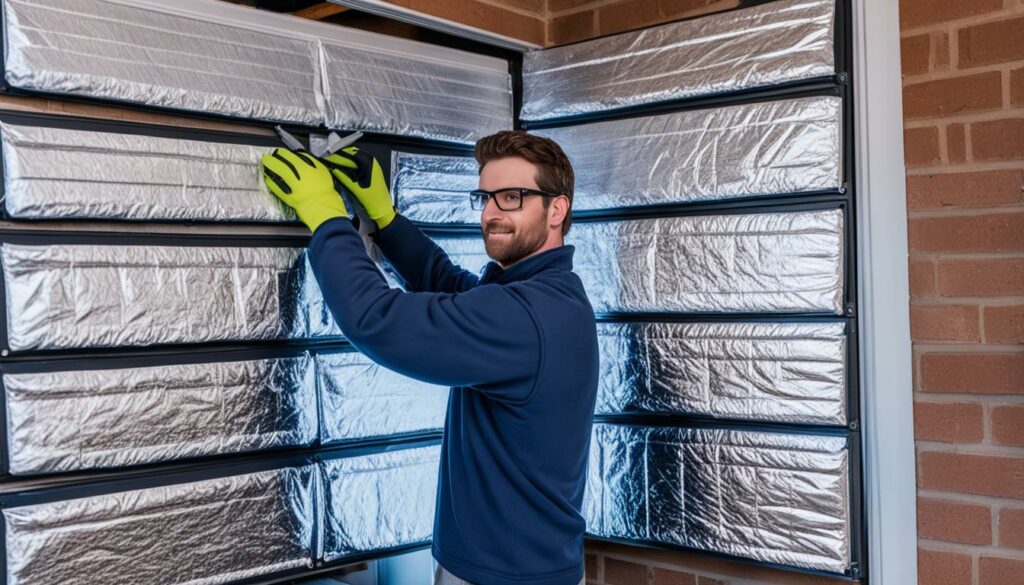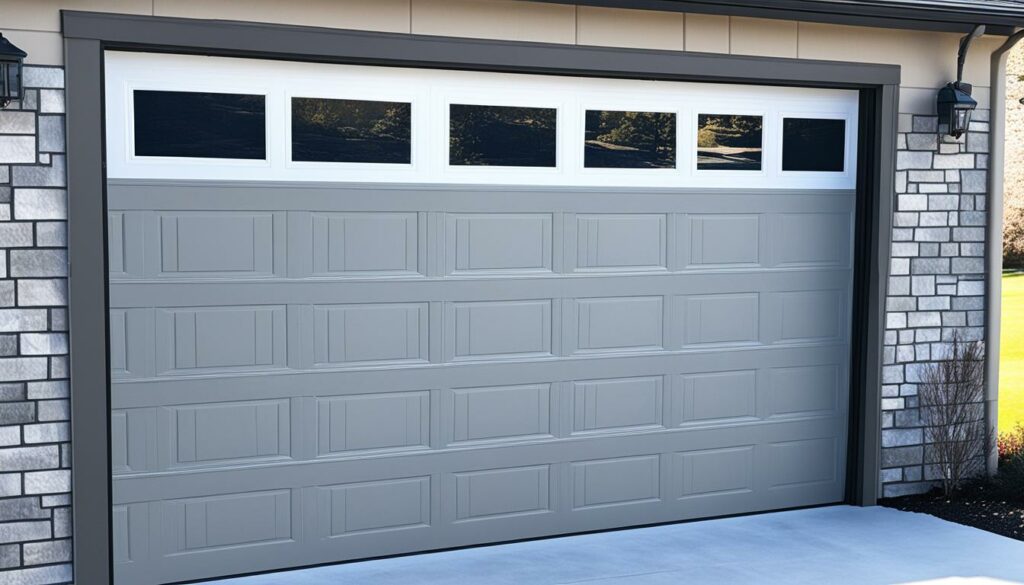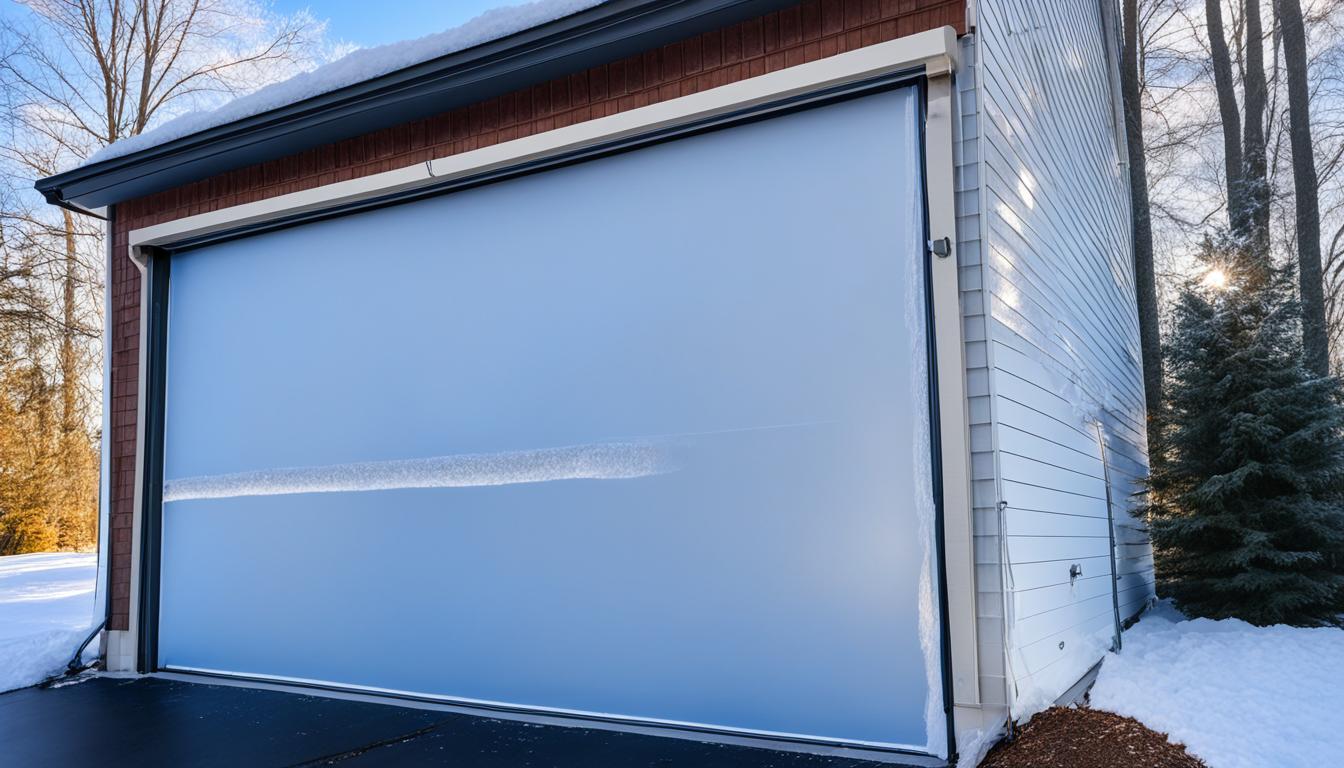Insulating a garage door panel is key for better thermal control. It makes your garage and home more comfy and energy-smart. You can use different ways to insulate, like installing panels, adding weatherstripping, or using reflective sheets. The best method depends on your budget, needs, and what you like.
We will look at various insulating techniques. And we’ll guide you through the steps to insulate your garage door panel well.
Key Takeaways:
- Insulating a garage door panel improves thermal efficiency.
- Methods for insulating include insulation panels, weatherstripping, and reflective insulation.
- The choice of insulation method depends on budget and personal preferences.
- In this article, we will provide a step-by-step guide.
Do garage door insulation panels work?
Garage door insulation panels are a great way to make your garage more energy-efficient. They fit into the door sections to add extra insulation. This helps keep a stable temperature in your garage, no matter the weather outside. They also stop cold or hot air from getting in, which makes your garage more comfortable.
Garage door insulation panels offer several important benefits:
- Improved thermal insulation: They help keep your garage’s temperature just right. This is good because it means you’ll use less energy to heat or cool your garage. So, you save money on power bills.
- Noise reduction: These panels also make your garage quieter. They block out noises from cars, lawnmowers, and loud neighbors. You can enjoy a peaceful space.
- Enhanced durability of the garage door: The panels protect your garage door. They guard it against weather, which can make it last longer. This saves you money on getting a new door early.
- Potential energy savings: A well-insulated garage uses less energy. It means you might not have to use as much power to heat or cool your home. This is good for your wallet and the environment.
| Benefits of Garage Door Insulation Panels |
|---|
| Improved thermal insulation |
| Noise reduction |
| Enhanced durability of the garage door |
| Potential energy savings |
Note: Table to showcase the key benefits of garage door insulation panels.
For more information about how do you insulate a garage panel?, contact us for expert advice on garage door repairs in Mango Hill.
What is the cheapest way to insulate a garage door?
To repair garage doors, one of the most cost-effective methods for insulating them involves using inexpensive materials like foam board or reflective insulation to achieve thermal efficiency without breaking the bank. Insulating for quieter operation of your garage door doesn’t have to be costly. Many budget-friendly options are available. They can help make your garage more energy efficient. You don’t need to spend a lot to insulate your garage door well.
Using bubble wrap or reflective insulation is a low-cost option. These add an extra insulation layer. Bubble wrap is cheap and keeps heat inside. Reflective insulation directs heat away, making your garage cooler in heat.
Another way is to use weatherstripping or foam tape to close gaps. These steps can improve insulation and keep the heat in. Weatherstripping, usually rubber or vinyl, is good for sealing your garage door’s edges well.
You might also want to try insulating panels. These are made of polystyrene foam or similar materials. They add another layer of insulation to your garage door.
Choosing these affordable insulation options will help. Your garage will be more comfortable and use less energy. This will reduce your bills. You just need a bit of time and a small investment.
Insulating your garage door doesn’t have to cost much. You can use options like bubble wrap, reflective insulation, weatherstripping, or foam tape to save on energy.
| Insulation Method | Benefits |
|---|---|
| Bubble wrap | Low-cost insulation solution Helps trap heat and prevent air leakage |
| Reflective insulation | Reflects heat away from the garage Effective in hot climates |
| Weatherstripping | Seals gaps and cracks in the garage door Prevents drafts and heat loss |
| Foam tape | Easy to install and affordable Improves insulation properties |
| Insulating panels | Provides an additional layer of insulation Enhances thermal efficiency |
How do I insulate the sides of my garage door?
Steps to insulate the sides of a garage door
It’s key to insulate your garage door sides for better insulation. This step stops drafts and boosts the door’s energy efficiency. It also keeps the garage warmer in winter and cooler in summer.
The two main ways to insulate a garage door’s sides are through:
- Using insulation panels
- Applying weatherstripping
Using insulation panels:
Start by measuring and cutting insulation panels to fit. Pick the right thickness for the best insulation. Then, attach them using adhesive or screws as directed. Make sure they cover the whole side well.
Applying weatherstripping:
Weatherstripping is another choice for sealing garage door sides. It’s easy and effective. Cut it to the needed length and stick or slide it into place. This step helps in keeping air inside the garage.
Both techniques improve your garage’s insulation. They also make the space more comfortable all year round.
How do you install insulation panels on a garage door?
Installing insulation panels on your garage door is pretty easy. It’s a simple DIY project. You can make your garage warmer in just a few steps.
Step-by-step guide to installing insulation panels on a garage door
- First, clean your garage door well. Remove all the dust and dirt. This makes it easier for the panels to stick.
- Next, measure where you’ll put the insulation. Cut the panels to fit these areas perfectly.
- Stick the panels on with adhesive or screw them in. Be sure they’re straight and secure. This keeps your garage well-insulated.
- Check for any open spaces that need sealing. Fill them with foam tape or weatherstripping. This perfects the insulation job.
Follow these steps, and you’re all set with insulated garage doors. You’ll notice a big difference. Check out the picture below to see how it’s done visually:

Now you know how to make your garage more energy efficient. Good insulation means a warmer, cheaper-to-heat space. You’ll save money and feel more comfortable.
Do I need a vapor barrier when insulating my garage?
Many people wonder if they should use a vapor barrier when insulating their garage. This barrier is key for stopping moisture from getting into your garage through the insulation. It’s very important, especially in places with a lot of humidity.
A vapor barrier helps stop condensation and moisture from building up. This matters a lot because too much moisture can cause mould. Mould is bad for health and can ruin your insulation and garage parts.
But, there might be times when you don’t need a vapor barrier. If your garage has good ventilation or the place isn’t humid, you might skip it. Always think about what your garage needs before deciding.
To choose right, think about the weather where you live and how much moisture your garage might get. Talking to an expert in insulation can help a lot. They can recommend what’s best for you. Consider factors like the type of activities you plan to do in your garage and whether you need temperature control for any stored items. Insulating your garage benefits not only your comfort but also the energy efficiency of your home, helping to reduce utility costs over time. Additionally, a well-insulated garage can provide a quieter and more versatile space for work or hobbies.
What type of insulation is best for garage doors?
Choosing the right insulation for your garage doors is key. Your choice affects how well your garage keeps heat, how easy it is to install, and the cost. The best insulation varies based on where you live, what you can spend, and what you like. Here’s a look at some top options:
Polystyrene Foam Insulation Panels
Polystyrene foam panels are both cheap and light. They’re simple to put in and keep your garage at a good temperature. You can cut these to fit your door, making them a great pick for many people.
Polyurethane Foam Insulation
Polyurethane foam is better at keeping your garage warm or cool than polystyrene. It seals air well, stopping heat from escaping and cold from getting in. While it might cost a bit extra, it offers more energy savings and a comfier garage.
Reflective Insulation
Foil insulation is excellent in places that get very hot. It bounces heat off, keeping your garage cooler. It’s put on your door’s inside and stops most heat from coming in. This kind of insulation is light, easy to use, and keeps things nice and cool.
Think about your local weather, how much you want to spend, and the level of insulation you need. Each type of insulation has its pluses and minuses. Picking the right one can make your garage more efficient, cozier, and lower your heating and cooling costs.

What is the best material for insulation door panels?
Choosing the best material for your garage door’s insulation panels is important. You’ll want a material that insulates well, lasts long, and is easy to install. Here are three materials often used for garage door insulation panels:
- Polystyrene foam: These foam panels are lightweight and affordable. They offer good insulation.
- Polyurethane foam: For better insulation and sealing, choose polyurethane foam. It’s efficient and can lower energy costs.
- Fiberglass: Fiberglass panels are excellent at keeping heat in. They’re also moisture and pest resistant.
Think about your budget, how much insulation you need, and your garage’s specific needs. Each material has its pros and cons. Pick the one that matches what you’re looking for in insulation.
How thick should garage door insulation be?
When seeking repair services, it’s crucial to consider the optimal thickness of garage door insulation to ensure energy efficiency and climate control in your space. How thick the insulation should be depends on a few things. These include where you live, how warm you want your garage, and the type of insulation.
For good insulation, go for at least 1 inch thickness. If it’s really cold where you live, consider 2 inches or more. This will keep your garage nice and warm.
You must make sure the insulation you pick doesn’t stop the garage door working right. Check how much space you have between door panels. Then, choose insulation that fits without getting in the door’s way.
The right thickness of insulation is key for saving energy and keeping your garage comfortable. Think about your climate, how much insulation you need, and the door type. This will help you pick the perfect insulation thickness for your garage door.
| Climate Zone | Recommended Insulation Thickness |
|---|---|
| Warm Climate | 1-2 inches |
| Moderate Climate | 1.5-2.5 inches |
| Cold Climate | 2-3 inches |
Can I insulate my own garage door?
Pros and Cons of DIY Garage Door Insulation
Insulating your own garage door is a cheap option consider a cost-effective garage door solutions, avoiding the cost of hiring an expert. Doing it yourself lets you pick the best insulation for your needs. You also get a great feeling of achievement from a successful DIY project.
However, DIY insulation comes with its own set of challenges. It’s essential to understand both the positives and negatives.
Pros:
- Cost Savings: You’ll save on the cost of labour by doing it yourself.
- Customization: Tailor the insulation to meet your personal preferences and needs for the best results.
- Pride of Accomplishment: A successful DIY project enhances your home and brings a sense of pride.
Cons:
- Additional Time and Effort: DIY work can be more time consuming than using a professional, since you need to learn the correct methods.
- Manufacturer Instructions and Safety: Following the instructions and safety guidelines carefully is essential to avoid mistakes or risks.
- Complexity and Skill Level: Some garage doors may be very complicated, needing the skill of a pro to get the work done right. It’s important to evaluate the work needed and your own skills before proceeding.
Getting your garage door insulated well depends on your readiness to learn, prepare, and work hard. Might need help if you’re unsure or if your door is difficult.
What is the least expensive garage insulation?
Affordable garage insulation materials
Looking for a cheap way to insulate your garage? Try out fiberglass insulation. It’s sold in rolls or batts. While it is affordable, it does the job well in keeping your garage warm. While exploring garage door repairs, consider utilizing fiberglass batts as they are often considered the least expensive option for insulating your garage.
Reflective insulation, like foil, is another option. It bounces heat away from your garage, making it cool. This is especially good if you live in a hot area. It keeps the summer heat outside.
Need something that won’t break the bank and is only for a short time? Think about using bubble wrap or bubble foil. They are easy to get and put up. For a quick fix, they help keep the inside temperature steady.
To fill in gaps and better seal your garage, try weatherstripping and foam tape. They’re inexpensive and simple to use. These tweaks can do a lot to cut down on draft and heat loss. With just a little cost, your garage becomes better insulated.
Garage Door Repair Near You
If you’re experiencing garage door problems, contact Jarred at Impact Doors for expert garage door repair. Our experienced team is dedicated to providing high-quality repairs. Call us today at (07) 5451 4022 for all your garage door repair needs.

